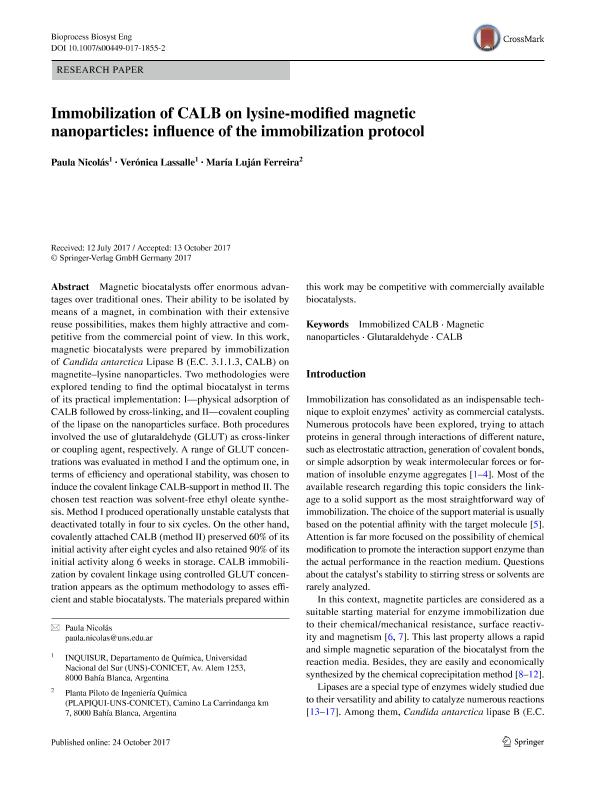Artículo
Immobilization of CALB on lysine-modified magnetic nanoparticles: influence of the immobilization protocol
Fecha de publicación:
13/10/2017
Editorial:
Springer
Revista:
Bioprocess And Biosystems Engineering
ISSN:
1615-7591
e-ISSN:
1615-7605
Idioma:
Inglés
Tipo de recurso:
Artículo publicado
Clasificación temática:
Resumen
Magnetic biocatalysts offer enormous advantages over traditional ones. Their ability to be isolated by means of a magnet, in combination with their extensive reuse possibilities, makes them highly attractive and competitive from the commercial point of view. In this work, magnetic biocatalysts were prepared by immobilization of Candida antarctica Lipase B (E.C. 3.1.1.3, CALB) on magnetite–lysine nanoparticles. Two methodologies were explored tending to find the optimal biocatalyst in terms of its practical implementation: I—physical adsorption of CALB followed by cross-linking, and II—covalent coupling of the lipase on the nanoparticles surface. Both procedures involved the use of glutaraldehyde (GLUT) as cross-linker or coupling agent, respectively. A range of GLUT concentrations was evaluated in method I and the optimum one, in terms of efficiency and operational stability, was chosen to induce the covalent linkage CALB-support in method II. The chosen test reaction was solvent-free ethyl oleate synthesis. Method I produced operationally unstable catalysts that deactivated totally in four to six cycles. On the other hand, covalently attached CALB (method II) preserved 60% of its initial activity after eight cycles and also retained 90% of its initial activity along 6 weeks in storage. CALB immobilization by covalent linkage using controlled GLUT concentration appears as the optimum methodology to asses efficient and stable biocatalysts. The materials prepared within this work may be competitive with commercially available biocatalysts.
Palabras clave:
Calb
,
Glutaraldehyde
,
Immobilized Calb
,
Magnetic Nanoparticles
Archivos asociados
Licencia
Identificadores
Colecciones
Articulos(INQUISUR)
Articulos de INST.DE QUIMICA DEL SUR
Articulos de INST.DE QUIMICA DEL SUR
Articulos(PLAPIQUI)
Articulos de PLANTA PILOTO DE INGENIERIA QUIMICA (I)
Articulos de PLANTA PILOTO DE INGENIERIA QUIMICA (I)
Citación
Nicolás, Paula; Lassalle, Verónica Leticia; Ferreira, María Luján; Immobilization of CALB on lysine-modified magnetic nanoparticles: influence of the immobilization protocol; Springer; Bioprocess And Biosystems Engineering; 41; 2; 13-10-2017; 171-184
Compartir
Altmétricas




